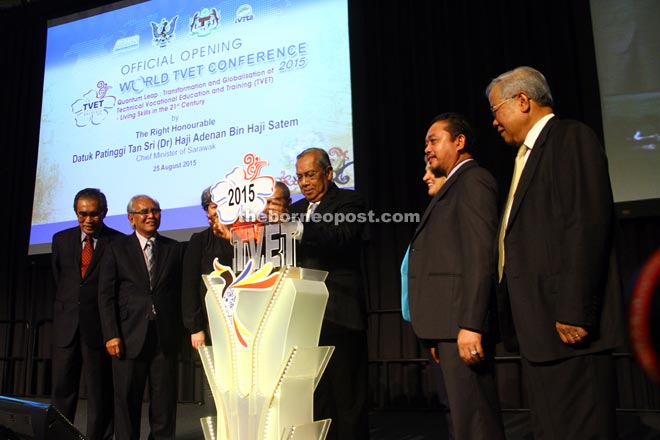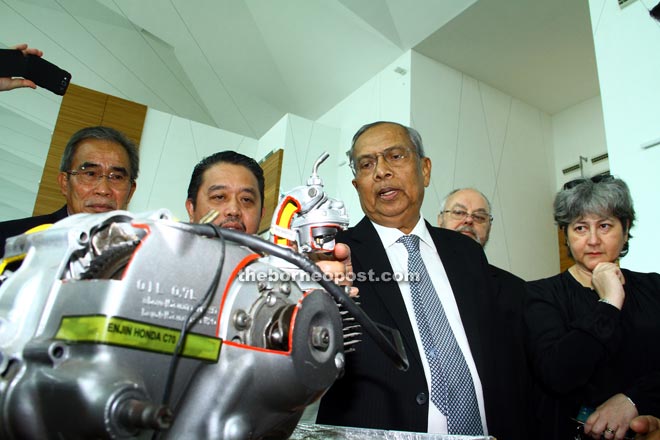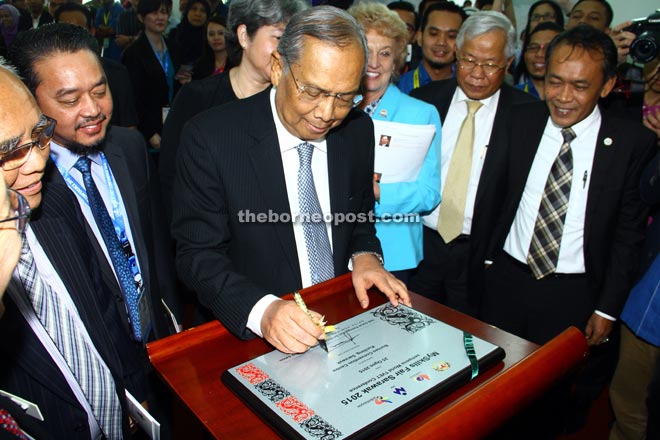Adenan says present setup inadequate to meet demand for more skilled workers in Sarawak

Adenan (centre) launching World TVET Conference 2015 while (from left) Len Talif, Jabu, Treadell (partly hidden), Thompson (partly hidden) Abdul Aziz and Manyin look on.

Adenan (third right) tries his hands at a machine during a visit to a booth at MySkills Fair Sarawak 2015. Also seen are (from left) Len Talif, Abdul Aziz and Treadell (right).

Adenan signing a plaque to launch MySkills Fair Sarawak 2015.
KUCHING: Sarawak will require a three-fold increase in enrolment for technical vocational education and training (TVET) in order to meet the state’s and nation’s need for skilled workers by 2030.
According to Chief Minister Datuk Patinggi Tan Sri Adenan Satem, the state currently has 54 public and 35 private TVET institutions, with a total capacity of about 30,000 places.
“These institutions jointly produce an annual output of about 11,000 certificate holders in different trades. At current rate, we would only be able to produce about 170,000 skilled workers by 2030.
“We need to substantially increase our training capacity. The present set-up is inefficient,” he said when launching World TVET Conference 2015 and MySkills Fair Sarawak 2015 at Borneo Convention Centre Kuching yesterday.
Adenan said a larger skilled workforce would be required, in line with the expectation of Sarawak Corridor of Renewable Energy (SCORE) to attract investments of over RM300 billion by 2030.
He cited a study by Universiti Malaysia Sarawak (Unimas) estimating that by 2030, a total of 1.33 million new jobs would be created, of which more than 50 per cent, or more than 600,000, would require skilled or semi-skilled workers.
Adenan also stressed on the importance of cooperation between the government and the private sector in developing the TVET sector, adding TVET institutions must collaborate with the industry players to be able to understand their requirements.
“The state government, through Yayasan Sarawak, has established the Centre for Technical Excellence, or Centex. The unique feature of Centex is that all its programmes are developed in close consultation with and direct involvement of industry players, thus assuring the relevance of the training received to the demands of the industry.”
He noted that within the 11th Malaysia Plan (11MP), at least two more Centex would be established, with the one in Lundu to start operations this year using temporary facilities, as the new campus was being built.
“PPKS or Sarawak Skills Development Centre will also establish new centres in Mukah and Lawas, while existing centres in Kuching and Miri will be expanded. We are also grateful to various federal agencies that are also expanding their presence in Sarawak.”
“The Education Ministry has converted six schools to become vocational colleges. We hope there will be more as these vocational colleges will become a major supplier of trained skilled workforce in the future.
“We hope that the ministry will continue to add more community colleges so that the target of one community college in each parliamentary constituency can be achieved as soon as possible.”
Adenan said the state government also welcomed Mara’s effort to progressively build more Giat Mara centres.
“We also facilitate and help the private sector to establish more skills training institutions and the existing ones to expand their operations. Last year alone, at least five new private skills training providers have started their operations in Sarawak.”
He said while the state government increased the capacity, it was also important to develop and implement specific strategies and initiatives to attract “our boys and girls to undertake TVET courses”.
“TVET was generally perceived to be a less attractive pathway compared to the conventional university education. It was often regarded as an option to those academically poor students who were not able to continue their studies at tertiary levels.
“Consequently, TVET programmes are shunned not only by the students but their parents and the society in general. A mental revolution was needed.”
It was for this reason, he added, that the government set up Tegas or Tabung Ekonomi Gagasan Anak Sarawak, a non-governmental organisation fully supported and funded by the state government with the specific responsibility of promoting TVET especially to rural students in Sarawak.
“I’m happy to say that through the effort of Tegas, the perception of Sarawakians towards TVET is slowly changing. More and more students and parents understand and acknowledge the value of TVET in acquiring skills and knowledge that are demanded by employers and its potential for a high income career.
“Consequently, they are accepting TVET as the preferred choice and the enrolment in our TVET institutions has gone up from 67 per cent in 2013 to about 85 per cent in 2015.”
Among those present at the launching were British High Commissioner to Malaysia Her Excellency Vicki Treadell, Deputy Chief Minister Datuk Patinggi Tan Sri Alfred Jabu, Sarawak Skills Development Centre chairman Tan Sri Datuk Amar Abdul Aziz Husain, Infrastructure Development and Communication Minister Dato Sri Michael Manyin, Assistant Minister in the Chief Minister’s Office (Promotion of Technical Education) Datu Len Talif Salleh and International Vocational Education and Training Association (Iveta) president Carmel Thompson.
